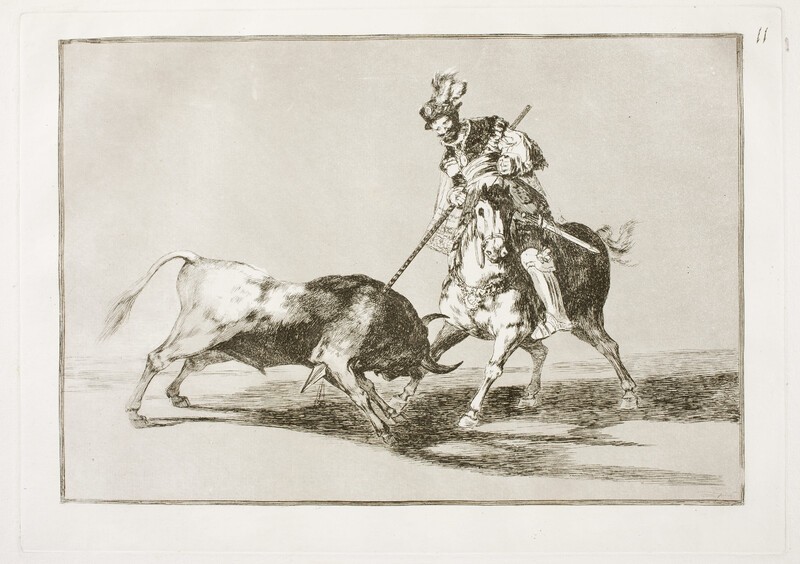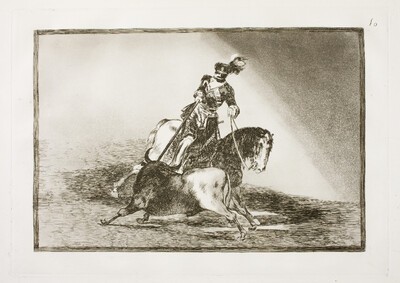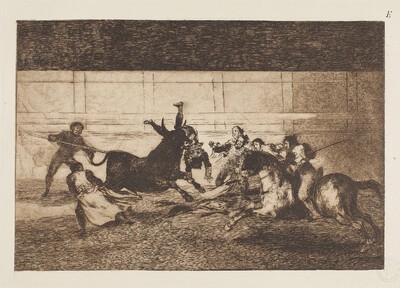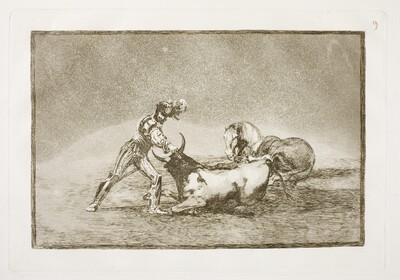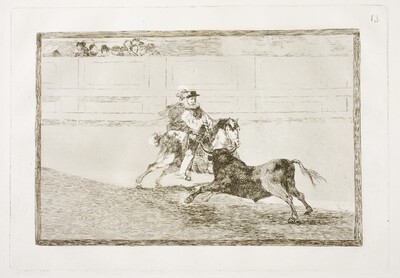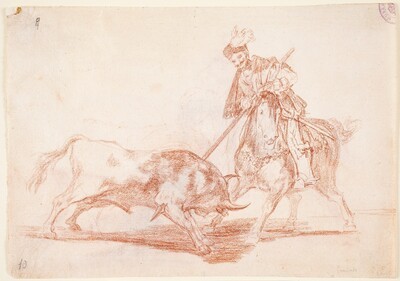- Cronología
- 1814 - 1816
- Dimensiones
- 249 x 351 mm
- Técnica y soporte
- Reconocimiento de la autoría de Goya
- Documented work
- Ficha: realización/revisión
- 01 Oct 2021 / 22 Jun 2023
- Inventario
- -
11 (print, upper right-hand corner)
Goya (vertical, printed, lower right corner)
See How the ancient Spaniards hunted bulls on horseback in the countryside
A state proof, made before the aquatint was applied, has been preserved.
The copperplate is conserved in the National Chalcography (no. 344) and has The death of Pepe Hillo ( Bullfighting E) engraved on the reverse.
See How the ancient Spaniards hunted bulls on horseback in the countryside
Another scene from the history of bullfighting, in this case the bullfighting of historical figures. We see Cid, mounted on his horse, thrusting his lance into the bull, which is pierced by the spear, the tip of which is sticking out from under the animal. In this case, as in the preceding print, the scene is not located in a specific place either, as no clues are given as to where it might take place. The work belongs to the subgroup devoted to the origins and chivalrous nature of bullfighting on horseback (nos. 9-11 and 13).
It has been pointed out that the Cid's costume is anachronistic, and it has generally been concluded that Goya's aim was to relate the event from his personal point of view, not to present the facts in an absolutely truthful manner. In relation to this, it is known that in the royal functions in the Plaza Mayor in Madrid, the bullfighters used to dress in old-fashioned costumes and that for the spectators these old-fashioned costumes were considered to be the authentic costumes of the knights.
This and the other two scenes of chivalrous horsemen with which it forms a subgroup, Charles V lancing a bull in the bullring in Valladolid and A Spanish knight in the bullring breaking small lances without the help of the pimps, are notable for their movement, each of them having been depicted from a different point of view.
Due to its composition and subject matter, the print is also related to another in the series, The spirited Moor Gazul is the first to lance bulls in rule, although here Cid is depicted as a more skilled knight than the Moor Gazul, as he holds the lance with only one hand and not with two as the Moor Gazul does.
There are two preparatory drawings of the present print, also entitled Cid Campeador lancing another bull, one of which has the scene depicted in the opposite direction to what will eventually be done in the engraving.
Ceán Bermúdez had placed the print after the six dedicated to the Moors and before number 10, which deals with Charles V. However, Goya did not accept this and decided to leave it in the position and order he had initially fixed, although this made the series incoherent from a chronological point of view, as the Cid was a character who came much earlier in time than Charles V.
The bottom of the copper plate has suffered a great deal of damage, although the part of the bull has been well preserved, where the burnisher's work can be seen.
-
Grabados y dibujos de Goya en la Biblioteca NacionalBiblioteca NacionalMadrid1946catalogue Elena Páez Ríos
-
Goya en la Biblioteca Nacional. Exposición de grabados y dibujos en el sesquicentenario de su muerteBiblioteca NacionalMadrid1978May - June 1978
-
Grabados de Goya: colección propiedad de la Biblioteca Nacional, que se conserva en su Gabinete deCasa de la Amistad de MoscúMoscow1979exhibition displayed from January 18th to 31st 1979
-
1984
-
Madrid1987
-
Madrid1990
-
Goya grabadorFundación Juan MarchMadrid1994consultant editors Alfonso E. Pérez Sánchez and Julián Gállego, from January 14th to March 20th 1994
-
Goya grabadorMuseo del Grabado Español ContemporáneoMarbella1996from March 8th to May 5th 1996
-
Zaragoza1996
-
Schlaf der Vernunft. Original radierungen von Francisco de GoyaMunich2000
-
Madrid2002
-
Madrid2002
-
Bilbao2012
-
Zaragoza2017
-
Goya et la modernitéPinacothèque de ParisParís2013from October 11st 2013 to March 16th 2014cat. 27
-
1946pp. 177-216, espec. pp. 185 y 192
-
OxfordBruno Cassirer1964vol. II, 1964, p. 325, cat. 214
-
Vie et ouvre de Francisco de GoyaParísOffice du livre1970p. 277, cat. 1171
-
Goya, toros y torerosMadridMinisterio de Cultura, Comunidad de Madrid1990p. 94, cat. 25
-
MadridCaser-Turner1992pp. 30 y 39
-
Catálogo de las estampas de Goya en la Biblioteca NacionalMadridMinisterio de Educación y Cultura, Biblioteca Nacional1996cat. 331
-
MadridMuseo Nacional del Prado2001pp. 58-60
-
ParísPinacoteca de París2013p. 105
-
Goya. In the Norton Simon MuseumPasadenaNorton Simon Museum2016pp. 186-201
